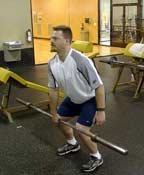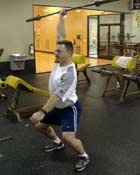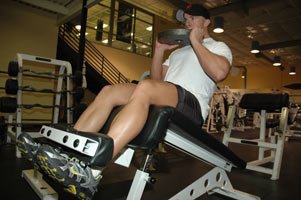God save us all from another hardgainer's manual. Is it even possible to cover this issue anymore? In one word: yes. If everyone figured out the magic equation to size and definition we'd have rid ourselves of this problem. It seems only a selective few are destined to achieve any semblance of muscular success. But that can't be true.
Deep down I know nearly everyone can engineer the body they want if they follow physiological principles. Said as if development should be done in a lab coat—which is a bandwagon I'm sure plenty of neophytes would join. Everyone gets caught in the hardgainer façade, because it's much easier to blame mom and dad for dealing a poor genetic hand.
Still, head turning biceps and abs remain the hallmark of success. All things worth having require a significant effort on your behalf to come to fruition. Most of these hardgainers are stuck on finding the 'secret' in lieu of finding patterns of success.
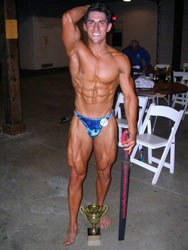
 Click Image To Enlarge.
Click Image To Enlarge. Author, Ryan Patrick: "Head Turning
Biceps & Abs Remain The Hallmark Of Success."
Forums are bogged down with questions regarding hush-hush secret supplements, exercise order, and which grip is the best for back development on the pull-up. Supplements have their place. As for a sound foundation to build upon? There is no substitute.
Save the razzle-dazzle for the Yuppies. Success leaves clues, so seek out people who are more successful than you and find out what they are doing. If anything in this article is worth repeating it's just this: Success leaves clues.
In it's final format, I've put together what I hope to be a fairly exhaustive overview of the training methods known to be the most successful for the aspiring iron addict. What you won't find here is a written plan with empty guarantees.
On the flip side, what you will find are tools in the toolbox with the knowledge to make your own decisions. It's not mandatory that you are an expert, but some rudimentary knowledge will ease uncertainty in the future.
Planning The Workout
Before you create your own workout plan or decide to follow one from Bodybuilding.com you need to sit back and ask yourself a few simple questions. Programming is far more than just putting a bunch of exercises down on paper or designating Monday as "Chest and Biceps" day.
Question 1: What Is Your Goal?
Are you concerned mostly with size, strength, fat loss, or some other sport conditioning? Often, there is a disparity between what you want to do and what you need to do. I would recommend finding an expert who can help assess your current needs.
After you ascertain what basic goal you are going to approach you need to be specific and write it down so you can mentally grasp the difference between success and failure. Knowing the boundaries that separate success from failure is imperative.
Here are some examples of bad goals: I want to get stronger. I want to gain 10 pounds. A more realistic goal would be specific and have a set time frame with which to achieve it. Of course, it would have to be a reasonable time frame.
The following are examples of good goals: I want to improve my deadlift by 50 pounds in four months. I want to gain 10 pounds while keeping my body fat constant over the next six months.
Question 2: How Many Days Do You Plan To Workout?
The semantics of any routine are dependent on the amount of time available to workout. For instance, a person working out 3 days per week would likely benefit from more full body or an upper/lower split where as the guy working out 5-6 days per week will excel with a higher frequency body part approach.
In terms of body part training, everyone seems to think in terms of 7-day cycles (i.e. every Monday is chest, every Tuesday is back, etc). I won't dispute the fact that this works, but for very few I think this is optimal. I don't subscribe to the philosophy that having one day a week to assault a specific muscle group is the best way to train.
You can get a training effect and resultant adaptation without excessive volume and leave yourself within striking distance of another workout sooner than 7 days away.
We'll get into this more later, but I've seen people excel going 3 days on/1 day of and others going only 3 days per week. I think most people fall somewhere in between, roughly around a 5-6 day split.
Question 3: What Was I Previously Doing And What Has Previously Worked For This Goal?
If you're not achieving success now, why not? Evaluate your current protocol and look for potential areas to improve or overall changes that may be a huge benefit. Be your worst critic. Also, success leaves clues so find out what the big boys are doing and pick up a few tips from them.
For some, the above questions are general platitudes. These alone will not create a bulletproof program, but it will help to seal a few leaks. Having a clear idea of where you are and exactly where you want to go will expedite the process.
Reps: The "How Many" Question
Trying to achieve maximum development is a time consuming (years) task, but let's not make a mountain out of a molehill. If everything is taken into account, it's a systematic process. If you aren't progressing then we change a few variables, assess and reassess the results.
With regard to reps, for maximum muscle growth you need to use a variety of rep ranges. Not necessarily over the course of a single program, but throughout many programs over throughout the year. It's myopic to think only the 6-12 range is suitable for building muscle, because there are times when increases in strength.
| Rep Range | Primarily Improves | Via |
| 1-3 | Strength | Myofibrillar Hypertrophy Central Nervous System Synchronization and motor unit recruitment |
| 4-8 | Strength, Functional Hypertrophy | Myofibrillar Hypertrophy and to a lesser extent Sarcoplasmic hypertrophy, still powerful CNS taxation |
| 8-12 | Hypertrophy | Mix of Myofibrillar and Sarcoplasmic Hypertrophy, more of the latter |
| 12-20 | Hypertrophy, Muscular Endurance | Mainly sarcoplasmic hypertrophy, some other aerobic adoptions |
| 20+ | Endurance, some hypertrophy | Aerobic adaptations, some tissues respond favorably in terms of hypertrophy |
This chart above is not 100% set in stone, and there is variation among each rep range. Some might split the ranges up a little differently, but to dispute irrelevant details is majoring in the minor.
The 1-3 range is used by powerlifters for their main lifts (squat, bench, deadlift) a majority of the time. It's effective for developing strength, and can produce benefits downstream in terms of hypertrophy. For instance, a 12 RM (rep-max) is around 67% of your 1 RM.
Calculate Your One Rep Max Here
If you improve your 1RM, it would make sense to have a consequent increase in your 12RM. Thus, you've achieved more volume without adding extra sets or reps to your current plan. Perhaps this is why adding load is the favored progression.
Myofibrillar hypertrophy is characterized by increases in contractile proteins in the muscle, actin and myosin. With more of these proteins, you can create a more powerful contraction and lift a heavier weight—enter strength. For a lean individual this will create the dense, heavy look of muscles (also called myogenic tone) that is envied.
An increase in muscle size through sarcoplasmic hypertrophy is optimized with traditionally defined hypertrophy rep ranges (anywhere from 6-15+). The distinguishing element of this feature is a growth of sarcoplasm. This is just a fancy name for muscle cytoplasm—remember the 'stuff' that fills the middle of the cell. In essence, the cell becomes more filled with fluid without really adding contractile proteins to enhance strength.
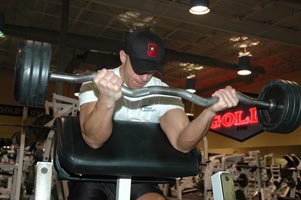
 Click Image To Enlarge.
Click Image To Enlarge. An Increase In Muscle Size Through Sarcoplasmic Hypertrophy
Is Optimized With Traditionally Defined Hypertrophy Rep Ranges.
The rate of accumulation and deconditioning of these two types of hypertrophy vary. They reverse approximately at the rate they accumulate. Thus when training stops, the sarcoplasmic hypertrophy will diminish first. Reduction of sarcoplasmic hypertrophy, however transient, is not a concern of someone following a regular training schedule.
Myofibrillar hypertrophy involves anabolic processes that require construction of new proteins. In this case when training stops, adaptation is more permanent.
If you have ever quit working out for any length of time you'll know you feel scrawny and small once you resume working out. Your work capacity may be atrocious upon your return, but you'll notice that strength levels often don't diminish much over the course of a few months. Although your ability to lift maximal weights over multiple sets is unrewarding.
The usual counsel is to vary your rep ranges. This is sage advice, but it isn't definitive enough for the rookie to grasp. First of all, what time frame is supposed to be 'understood' by saying vary? Does this mean vary week to week, between programs or on some other cyclical basis?
Varying your rep ranges doesn't inherently mean each exercise of a program needs to be within a given rep range (everything 1-3, then everything 8-12, etc). There should be some variance in your program; compound movements should typically consist of heavier weights and lower rep.
However, deviation from this works well, especially with exercises like 20-rep squats (a la widowmaker). Rotation of programs and reps should happen roughly every 4-6 weeks.
For isolation exercises it's pretty common to use ranges over 6. Keep in mind is there are not many rules etched into stone tablets. If necessity dictates, drop to 3, 4 or 5-rep sets on hammer curls or other isolation exercises.
Time Under Tension (TUT) And Tempo
Time under tension is pseudo science jargon for the amount of time a set takes, or the amount of time the muscle is under tension. This can actually be a misnomer because trainees typically let the muscle relax in order to try and grind out a few more reps.
Tempo is simply the speed of the lift usually divided into 3 parts. You'll commonly see a set of 3 numbers together such as 3-1-1 or 2-1-2. This designates the eccentric (or lowering), pause (if any) and concentric (lifting) portion of the exercise.
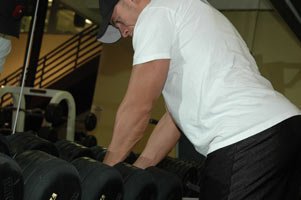
 Click Image To Enlarge.
Click Image To Enlarge. Trainees Typically Let The Muscle Relax In
Order To Try And Grind Out A Few More Reps.
Normal exercise cadence is 1-0-1. One second lowering, no pause, and one second lifting. Some literature may call to replace the concentric portion with an 'X.' This is to designate a lift be executed with the intention of moving it as fast as you can.
I want to forewarn you that further research in this area debates over the speed of the muscle shortening (contracting) versus the actual speed of the bar moving. This minute detail has application to powerlifting and sport in general, but less practical for your immediate needs.
Volume is king. It is volume that builds hypertrophy, not weight alone. You can manipulate volume by changing the rep scheme, increasing weight or increasing time under tension.
Charles Poliquin stated that it takes between 30-70 seconds during a set to build hypertrophy. If that's true your 10-rep sets at a normal cadence (1-0-1) would only last 20 seconds. Once you reap the effortless gains at the outset, you'll have to pay attention to time under tension because it can be a significant factor.
TUT isn't about counting seconds. The intention is to keep tension on the muscle as it lengthens. Deliberate. Slow. But don't lose focus.
Rep Cadences
There are three main types of lifts: constant tension, explosive and a controlled-eccentric with fast-concentric. Of course you could make a case for the negatives or 1 1/2's, but that really exceeds the needs of most typical programs.
In the previous section I talked about needing a specific amount of time under tension to stimulate hypertrophy. For your compound movements, this is rather difficult to have such an exaggerated negative. You're overloading several muscle groups and holding a negative too long will quickly shift the load to muscles you aren't desiring to work as much.
Case in point: try a negative on a barbell row, almost everyone will feel it in their biceps instead of their upper backs. Christian Thibaudeau had a lot of influence on my thoughts in this section.
Thus, for compound exercises using a controlled negative is ideal. The purpose of this is simply that, control. You aren't intentionally increasing the duration, but just making it smooth—perhaps a 2-3 count. At the bottom you'll use no pause or a brief 1-second pause. For most people I don't recommend a pause, simply because they can't maintain a tight position at the bottom of the lift.
After the pause you want to lift the bar as fast as you can to the starting position. In a nutshell, the lift is 20X; controlled, brief or no pause, then all you got. When it comes to the compound movements leading off your workout, I don't think it's wise or necessary to train to failure. For the first few opening lifts I would leave 1-2 reps "in the tank" on each set.
Delts, traps, arms grow especially well with doing reps under constant tension. I think front delt raises are the best example of how this method doesn't work. You lift one arm, let it flop back down, then lift the other arm. For each rep you do, the opposite arm is relaxing.
Constant tension is literally just that, not one break for your muscles. It's true that it's humbling, but staying contracted will induce a state of hypoxia and more lactic acid. Lactic acid is good for growth hormone release and staying tight the entire time will increase the time under tension.
To employ this technique you need to understand a little bit about muscle mechanics or tune into your body. Learn where the tension is taken off the target muscle group and on to another body part.
Let's say you were using a dumbbell fly. At the top of the movement, where most people click the dumbbells together (which is pointless anyway) the tension is actually not on your chest. Most likely your shoulders are supporting the weight, but being in full horizontal abduction is easy to flex your pecs.
If you stopped a few degrees short on each arm and went right back down you would notice your chest "burning out" much quicker. Constant tension is best served by a tempo with a long eccentric. Do away with taking the big breath between each rep of curls.
When doing the isolation exercises I suggest going until they're toasted. Biceps, triceps, and the like are barely taxing to the central nervous system so recovery is unlikely going to be an issue. Yes, permission to totally blast the biceps.
Explosive lifting is best illustrated by the Olympic lifts. These are often too technical for the novice, so I'll touch on them briefly. The basic premise is to use power to target your type IIx fibers. These are the muscle fibers that have the most potential for strength and growth.
Generally few reps are done with these exercises; between 2 and 8 reps is most common. These are highly taxing to the nervous system and with a traditional high volume bodybuilding approach addition of these exercises can quickly instigate overtraining.
With that being said, a few sets of a one-arm barbell snatch at the beginning of your hip dominant (hamstring or leg) day would help fire up the CNS for work to follow. The one-arm barbell snatch is an elementary movement for the o-lifts and the first I'd recommend to people.
If you so choose to use explosive lifting in your program, remember it should come before everything else due to the high demand of the CNS. Next up you should follow with your compound lifts using controlled eccentrics and fast concentric.
I would ignore pre-fatigue methods (flyes before presses) initially. Find out how well you grow once you implement the basics and then make changes accordingly. Finish up with your isolation exercises using constant tension to exhaustion.
Volume And Frequency
The more workouts you can get in and recover from, the faster you will grow. If you could heal like Wolverine, then you could literally pack a year's worth of working out into a single week. If frequency is so important you have to wonder, "why is everyone doing one body part once per week?"
The catch with volume and frequency is that there is a trade-off. When one goes up, almost certainly the other must go down. There is no way you can do 20 sets per body part twice per week. It will wear you down after a few short weeks, if not sooner.
If you are capable of recovering from the workload, hitting your muscles twice per week seems to be optimal for growth. Within each session it's important to have enough volume to induce a training effect. Meaning, you need to have enough sets/reps/time under tension to force your muscles to adapt and grow.
If the frequency of two times per week is too much exercise, then you are not banished to hitting everything once per week. People get stuck inside the box. By doing this you are doing yourself a disservice.
There is no reason that if a 2x per week split fails, you couldn't switch to a 5-day split and hit everything twice in 10 days. This will allow you to have more recovery than two sessions per week, but still get back in the gym more frequently.
Here are some examples of splits:
5-Day Splits
- Day 1: Chest and Back
- Day 2: Legs
- Day 3: Rest
- Day 4: Shoulders and Arms
- Day 5: Rest
- Day 1: Upper Body
- Day 2: Lower Body
- Day 3: Rest
- Day 4: Full Body
- Day 5: Rest
2x Per Week Splits
- Day 1: Upper Body
- Day 2: Lower Body
- Day 3: Rest
- Day 4: Upper Body
- Day 5: Rest
- Day 6: Lower Body
- Day 7: Rest
- Day 1: Chest and Quads
- Day 2: Back and Hamstrings
- Day 3: Shoulders and Arms
- Day 4: Chest and Quads
- Day 5: Back and Hamstrings
- Day 6: Shoulders and Arms
- Day 7: Rest
This split I usually significantly cut the shoulder work or even skip it one day six. You are pushing or pulling every day of the week so it can take it's toll trying to do a shoulder day. I do little overhead pressing—1, maybe 2 shoulder pressing exercises for the week.
3-On 1-Off
- Day 1: Chest and Quads
- Day 2: Back and Hams
- Day 3: Shoulders and Arms
- Day 4: Rest
- Day 1: Chest and Back
- Day 2: Legs
- Day 3: Shoulders and Arms
- Day 4: Rest
People always ask, "What do you think of my program?" They'll list splits such as I have above. But there is nothing to assess with a simple layout.
The amount of sets and reps, the intensity techniques, the time under tension—the variables can seem endless and vary significantly between people. Essentially, the volume prescribed between two individuals could be exponentially different. No discussion of volume should go without a look at Prilepin's Chart (below):
| Percent Range | Reps Per Set | Optimal Total Reps | Acceptable Volume Range |
| 60-69% | 4-8 | 20 | 18-30 |
| 70-79% | 3-6 | 18 | 12-24 |
| 80-89% | 2-4 | 15 | 10-20 |
| 90-99% | 1-2 | 4 | 4-10 |
| 100% | 1 | 1-2 | 1-2 |
The one flaw with this chart is that it was done for Olympic lifters and may not necessarily hold as much relevance with regard to lifting for size. But let's not throw the baby out with the bathwater.
Strength coach Mike Boyle sometimes uses a 5-10-20 rep scheme for a given at 82%-70%-58% respectively. You can see that the percentages don't 'agree' with the chart, but that doesn't negate their validity.
Mel Siff had a version of this chart in his landmark book, Supertraining:
| Variable | Strength | Power | Hypertrophy |
| Load (%1RM) | 80-100 | 70-100 | 60-80 |
| Reps Per Set | 1-5 | 1-5 | 8-15 |
| Sets Per Exercise | 4-7 | 3-5 | 4-8 |
| Rest (Mins) | 2-6 | 2-6 | 2-5 |
| Duration (Min/Secs Per Set) | 5-10 | 4-8 | 20-60 |
| Speed Per Rep (% Of Max) | 60-100 | 90-100 | 60-90 |
| Training Sessions Per Week | 3-6 | 3-6 | 5-7 |
You can see instantly that training for hypertrophy demands more sets, reps, time under tension (duration in the chart) and uses lighter loads. This doesn't mean strength or power aren't conducive to hypertrophy. In fact, I'd argue the person who tries to master all three in varying amounts through the course of years would be much larger than someone who just did hypertrophy.
What I will say regarding volume is that anywhere from 9-14 sets per muscle group, per workout sessions is the best. Much more than that and it will be difficult to recover from. In fact, the optimal range is probably 10-12. If you are doing workouts more frequently you still manage to squeeze out 20-24 sets in a week over two sessions.
These charts are guidelines, so don't get caught up in the science of it. I want to reemphasize the important points again: more workouts sessions is better, in fact twice per week is great if you can recover otherwise a 5-day split is great, ideal volume is 10-12 sets provided you have enough time under tension.
Exercise Guide
This is a list to jog your memory, but isn't exhaustive.
Quads:
- Squats
- Front Squats
- Split Squats
- Walking Lunges
- Reverse Lunges
- Step-Ups
- Dumbbell Squats
- Leg Press
- Leg Extensions
Glutes and Hamstrings:
- Deadlift
- Romanian Deadlift
- Stiff-Legged Deadlift
- Back Extensions
- Lying Leg Curl
- Good Mornings
- Long-Step Lunges
- Snatches
Calves:
- Seated Calf Raise
- Standing Calf Raise
- Leg Press Calf Raise
- Donkey Calf Raise
Abs:
- Planks
- Side Planks
- Sit-ups
Upper Back and Traps (Thickness):
- Bent-Over Barbell Rows
- Seated Cable Rows
- T-Bar Rows
- Hang Cleans
- Dumbbell Shrugs
- One-Arm Rows
Back (Width):
- Pull-Ups
- Lat Pull-downs
- Chin-Up
- Rope Pull-downs
- Straight-Arm Pull-downs
Chest:
- Bench Press
- Dumbbell Bench Press
- Incline Bench Press
- Dumbbell Incline Bench Press
- Machine Bench Presses
- Dumbbell Flyes
- Push-ups
Shoulders:
- Barbell Press
- Dumbbell Press
- Front Raise
- Lateral Raise
- Upright Rows
- Machine Shoulder Press
Biceps:
- Barbell Curls
- Dumbbell Curls
- Hammer Curls
- Zottman Curls
- Reverse Curls
Triceps:
- Close-Grip Bench Press
- Skullcrushers
- Dips
- V-Bar Press-downs
A Word About How To Get Huge
The perfect program doesn't exist. Regardless of how good your program is, you'll always do better with a "no fail" attitude. The best thing that you can do is surround yourself with like-minded people in the gym.
People who are stronger than you can always motivate you and teach you things as you are along the way. Some of the best powerlifting gyms in the world are that way because of the atmosphere.
I laid out some pretty simple ground rules for building a program from scratch. I didn't lay out a one-size-fits-all because it's myopic to think everyone can benefit from the exact same program regardless of background. There are plenty of resources and articles available here to follow up.

 Click Image To Enlarge.
Click Image To Enlarge. The Best Thing That You Can Do Is Surround
Yourself With Like-Minded People In The Gym.
Everyone who has the courage and motivation to write their own programs, feel free to send them to my email and I'll offer some suggestions to assist your efforts.
For the bored, lazy or forgetful here are a few bullet points to help:
- Know what resources you have and how much time you have to workout before determining your split.
- Utilize all rep ranges, switching roughly on a 4-6 week basis.
- Periods of strength and power are a perfect complement to traditional hypertrophy workouts.
- Volume and time under tension are key for growth but remember strength increases volume in a roundabout way.
- Use the bulk of exercises with three lifting styles:
- Explosive for Olympic lifts or other speed compound movements
- Controlled eccentrics, explosive concentric for compound movements
- Constant tension for isolation exercises
- 9-12 sets is ideal for body part splits.
- 3, 4 and 5 day splits provide more leeway than choosing "X" times per week to hit a body part.
- Building a respectable physique takes time with consistently applied effort towards nutrition and exercise—be patient.

